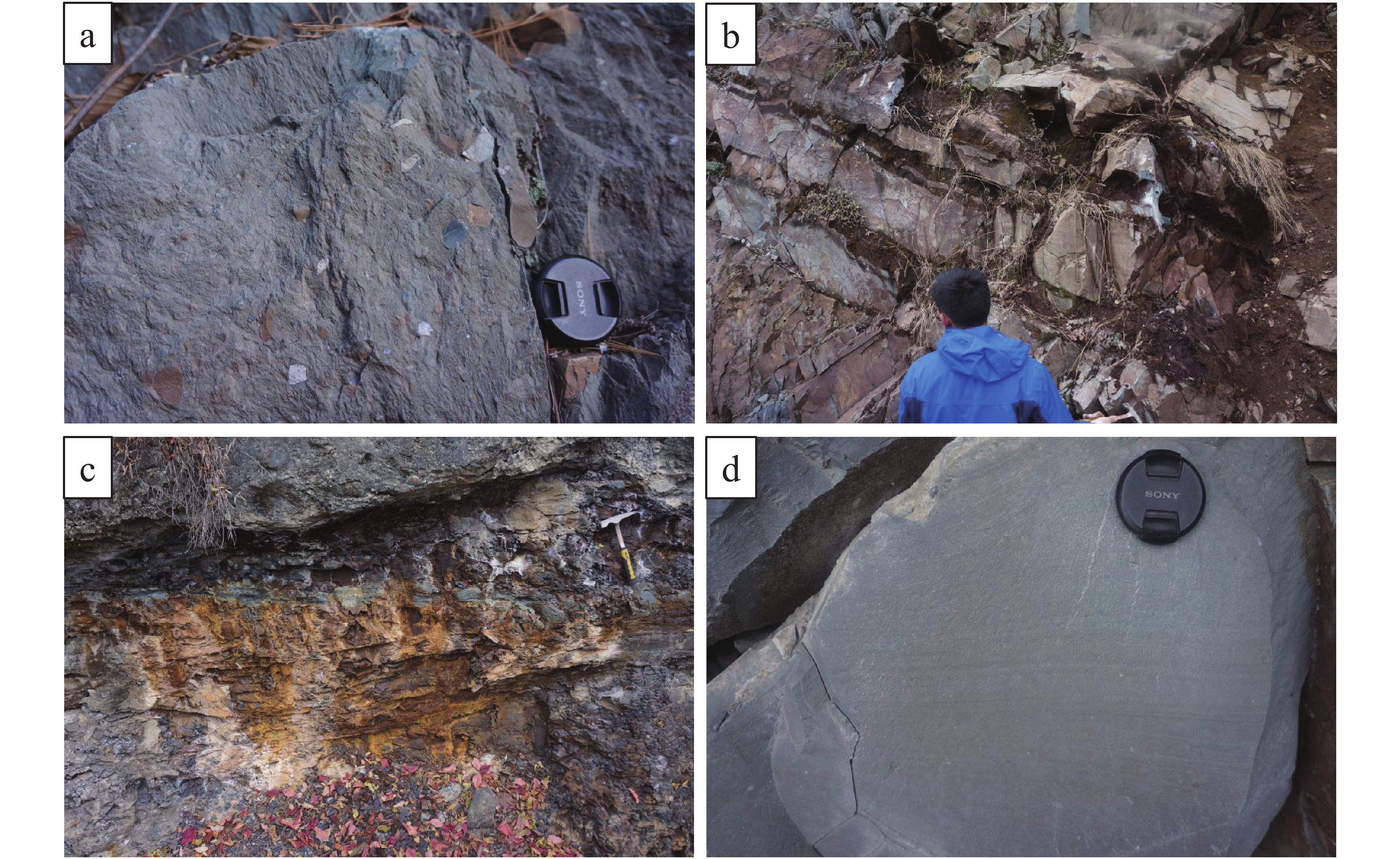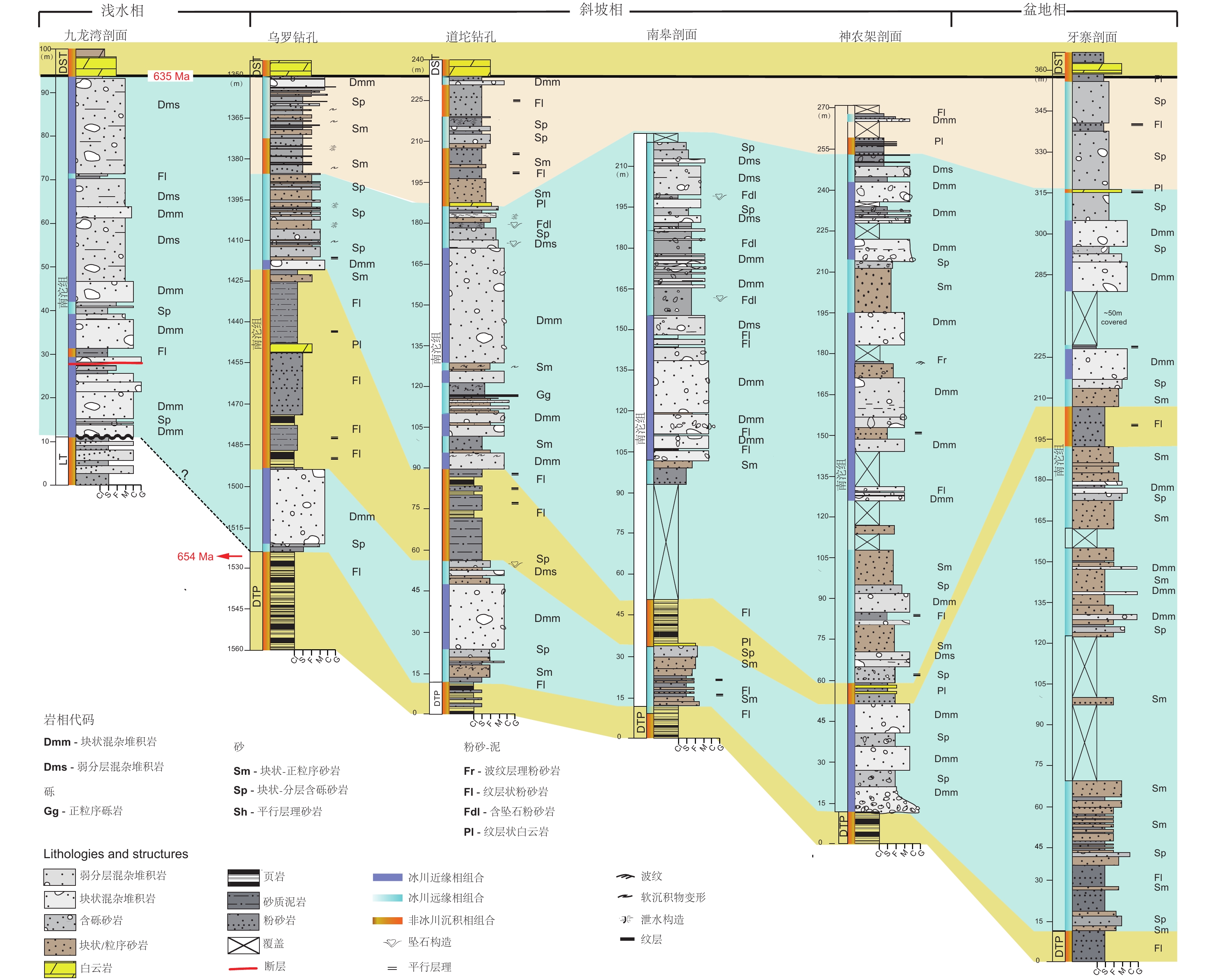Research progress on environmental effects of the Cryogenian global glaciation
-
摘要:
成冰纪全球冰期是地球历史上最极端的冰室气候事件,冰川作用波及赤道区域,全球可能都遭受了冰封,海洋广泛缺氧,生物演化进程迟滞。然而,冰期结束之后,大气氧浓度迅速升高,海洋发生逐步氧化,大型带刺疑源类和真核多细胞藻类在埃迪卡拉纪开始繁盛,出现最早的动物,地表生物圈发生了翻天覆地的变化。显然,成冰纪全球冰期事件是地球系统演化的重要转折。认识冰期的环境效应是认识埃迪卡拉纪生物演化的关键,也是打开地表宜居环境演化的钥匙。本文总结了近年来成冰纪全球冰期的气候假说、冰期沉积特征、海洋氧化还原条件及冰期后的大气与海洋环境剧变等方面的研究进展,简要分析了全球冰期研究中存在的问题,并对该领域未来研究提出了展望与建议。
Abstract:The Cryogenian global glaciation events are Earth's most extreme icehouse climate. During these glaciations, ice sheets extended to the equatorial region. It is suggested that the ocean was completely frozen and suffered from widespread marine anoxia, which delayed biological evolution. After the end of the glaciation, atmospheric oxygen levels significantly increased, leading to deep-ocean oxidation and the diversification of multicellular algae in the early Ediacaran. Obviously, the Cryogenian global glacial event was an important turning point in the evolution of the Earth system. Understanding how the glaciations altered the environment is the key to understanding biological evolution, and the habitable environment of the Ediacaran Period. The present paper provides a summary of recent research progress in the areas of climate hypothesis, glacial sedimentation characteristics, ocean redox conditions, and post-glacial atmospheric and marine environment drastic changes during the global glacial period. It also briefly analyzes the existing problems in global glacial research and proposes future research directions.
-
Key words:
- snowball Earth /
- Nantuo Formation /
- primary productivity /
- oxidation /
- Neoproterozoic
-

-
图 3 华南南沱组沉积序列与演化(Lang et al., 2018a)
Figure 3.
-
[1] Abbot D S, Pierrehumbert R T, 2010. “Mudball: Surface dust and Snowball Earth deglaciation”[J]. Journal of Geophysical Research: Atmospheres. 115: D03104. doi: 10.1029/2009JD012007.
[2] Abbot D S, Voigt A, Koll D , 2011. The Jormungand global climate state and implications for Neoproterozoic glaciations[J]. Journal of Geophysical Research: Atmospheres, 116(D18): 4121-4132.
[3] Allen P A , Etienne J L, 2008. Sedimentary challenge to Snowball Earth[J]. Nature geocience, 1(12): 817–825. doi: 10.1038/ngeo355
[4] 储雪蕾, 2004. 新元古代的“雪球地球”[J]. 矿物岩石地球化学通报, 23(3): 233-238 doi: 10.3969/j.issn.1007-2802.2004.03.010
Chu X L, 2004. Snowball Earth during the Neoproterozoic [J]. Bulletin of Mineralogy, Petrology and Geochemistry, 23(3): 233-238. doi: 10.3969/j.issn.1007-2802.2004.03.010
[5] 崔晓庄, 江新胜, 王剑, 等, 2014. 滇中新元古代裂谷盆地充填序列及演化模式: 对Rodinia超大陆裂解的响应[J]. 沉积学报, 32(3): 399-409 doi: 10.14027/j.cnki.cjxb.2014.03.004
Cui X Z, Jiang X S, Wang J, et al. , 2014. Filling sequence and evolution model of the Neoproterozoic rift basin in central Yunnan Province, South China: Response to the breakup of Rodinia Supercontinent[J]. Acta Sedimentologica Sinica, 32(3): 399-409. doi: 10.14027/j.cnki.cjxb.2014.03.004
[6] Eyles N, Januszczak N, 2004. ‘Zipper−rift’: a tectonic model for Neoproterozoic glaciations during the breakup of Rodinia after 750 Ma[J]. Earth−Science Reviews, 65(1–2): 1−73.
[7] 冯永, 顾尚义, 吴忠银, 等, 2021. 贵州五河南沱组形成的氧化还原环境: 地球化学与矿物学证据[J]. 矿物学报, 41(1): 33-44 doi: 10.16461/j.cnki.1000-4734.2020.40.150
Feng Y, Gu S Y, WU Z Y, et al., 2021. Oceanic redox condition of the Nantuo Formation at the Wuhe profile, Guizhou Province: Evidences from its geochemistry and mineralogy [J]. Acta Mineralogica Sinica, 41(1): 33-44. doi: 10.16461/j.cnki.1000-4734.2020.40.150
[8] He R, Lang X, Shen B, 2021. A rapid rise of seawater δ13C during the deglaciation of the Marinoan Snowball Earth[J]. Global and Planetary Change, 207.
[9] Hoffman P F, 2017a. Snowball Earth climate dynamics and Cryogenian geology-geobiology[J]. Science Advances, 3: e1600983. doi: 10.1126/sciadv.1600983
[10] Hoffman P F, Kaufman A J, Halverson G P, et al., 1998. A Neoproterozoic snowball earth[J]. Science, 281: 1342–1346. doi: 10.1126/science.281.5381.1342
[11] Hoffman P F, 2017b. Sedimentary depocenters on Snowball Earth: Case studies from the Sturtian Chuos Formation in northern Namibia[J]. Geosphere, 13(3): 811–837. doi: 10.1130/GES01457.1
[12] Hu J, 2020. Glacial origin of the Cryogenian Nantuo Formation in eastern Shennongjia area (South China): Implications for macroalgal survival[J]. Precambrian Research, 351.
[13] Huang J, Chu X, Jiang G, et al., 2011. Hydrothermal origin of elevated iron, manganese and redox-sensitive trace elements in the c. 635 Ma Doushantuo cap carbonate[J]. Journal of the Geological Society, 168(3): 805-816. doi: 10.1144/0016-76492010-132
[14] Huang K J, 2016. Episode of intense chemical weathering during the termination of the 635 Ma Marinoan glaciation[J]. Proceedings of the National Academy of Sciences, 113: 14904–14909. doi: 10.1073/pnas.1607712113
[15] Hyde W T, Crowley T J, Baum S K, et al., 2000. Neoproterozoic ‘snowball Earth’simulations with a coupled climate/ice-sheet model[J]. Nature, 405(6785): 425–429. doi: 10.1038/35013005
[16] Jiang G, Kennedy M J, Christie-Blick N, et al., 2006. Stratigraphy, Sedimentary Structures, and Textures of the Late Neoproterozoic Doushantuo Cap Carbonate in South China[J]. Journal of Sedimentary Research, 76(7): 978–995. doi: 10.2110/jsr.2006.086
[17] Johnson, B W, Poulton S W, Goldblatt C, 2017. Marine oxygen production and open water supported an active nitrogen cycle during the Marinoan Snowball Earth [J]. Nature Communications, 8: 1316
[18] Kirschvink J L, 1992. Late Proterozoic low−latitude global glaciation: the snowball Earth. The Proterozoic Biosphere: a multidisciplinary study[M]. Cambridge University Press, New York, 51–52.
[19] Lang X, 2018a. Cyclic cold climate during the Nantuo Glaciation: Evidence from the Cryogenian Nantuo Formation in the Yangtze Block, South China[J]. Precambrian Research, 310: 243–255. doi: 10.1016/j.precamres.2018.03.004
[20] Lang X, 2018b. Transient marine euxinia at the end of the terminal Cryogenian glaciation[J]. Nature Communications, 9(1): 3019. doi: 10.1038/s41467-018-05423-x
[21] Lang X, 2016. Ocean oxidation during the deposition of basal Ediacaran Doushantuo cap carbonates in the Yangtze Platform, South China[J]. Precambrian Research, 281: 253–268. doi: 10.1016/j.precamres.2016.06.006
[22] Le Heron D P, Tofaif S, Vandyk T, et al., 2017. A diamictite dichotomy: Glacial conveyor belts and olistostromes in the Neoproterozoic of Death Valley, California, USA[J]. Geology, 45(1): 31–34. doi: 10.1130/G38460.1
[23] Leather J, Allen P A, Brasier M D, et al., 2002. Neoproterozoic snowball Earth under scrutiny: Evidence from the Fiq glaciation of Oman[J]. Geology, 30(10): 891–894. doi: 10.1130/0091-7613(2002)030<0891:NSEUSE>2.0.CO;2
[24] Lechte M, Wallace M, 2016. Sub–ice shelf ironstone deposition during the Neoproterozoic Sturtian glaciation[J]. Geology, 44(11): 891-894. doi: 10.1130/G38495.1
[25] Lechte M A, Wallace W M, Hood S A, et al., 2019. Subglacial meltwater supported aerobic marine habitats during Snowball Earth[J]. 116(51): 25478−25483.
[26] Ma H, Shen B, Lang X, et al., 2022. Active biogeochemical cycles during the Marinoan global glaciation [J]. Geochimica et Cosmochimica Acta 321(3): 155-169.
[27] McKay C, 2000. Thickness of tropical ice and photosynthesis on a snowball earth[J]. Geophysical Research Letters, 27(14): 2153-2156. doi: 10.1029/2000GL008525
[28] Nascimento D B, Ribeiro A, Trouw R A J, et al., 2016. Stratigraphy of the Neoproterozoic Damara Sequence in northwest Namibia: Slope to basin sub-marine mass-transport deposits and olistolith fields[J]. Precambrian Research, 278: 108–125. doi: 10.1016/j.precamres.2016.03.005
[29] Pollard D, Kasting J F, 2005. Snowball Earth: A thin−ice solution with flowing sea glaciers[J]. Journal of Geophysical Research: Oceans, 110(C7).
[30] Rooney A D, Strauss J V, Brandon A D, et al., 2015. A Cryogenian chronology: Two long-lasting synchronous Neoproterozoic glaciations[J]. Geology, 43(5): 459–462. doi: 10.1130/G36511.1
[31] Sahoo S K, 2012. Ocean oxygenation in the wake of the Marinoan glaciation[J]. Nature, 489(7417): 546–549. doi: 10.1038/nature11445
[32] Shen W, 2022. Secular variation in seawater redox state during the Marinoan Snowball Earth event and implications for eukaryotic evolution[J]. Geology, 50(11): 1239-1244. doi: 10.1130/G50147.1
[33] Song H, An Z, Ye Q, et al., 2023. Mid-latitudinal habitable environment for marine eukaryotes during the waning stage of the Marinoan snowball glaciation [J]. Nature Communications, 14: 1564.
[34] Williams G E, 2008. Proterozoic (pre-Ediacaran) glaciation and the high obliquity, low-latitude ice, strong seasonality (HOLIST) hypothesis: Principles and tests[J]. Earth-Science Reviews, 87(3): 61-93.
[35] 闫斌, 朱祥坤, 唐索寒, 等, 2010. 广西新元古代BIF的铁同位素特征及其地质意义[J]. 地质学报, 84(7): 1080-1086 doi: 10.19762/j.cnki.dizhixuebao.2010.07.011
Yan B, Zhu X K, Tang S H, et al., 2010. Fe Isotopic Characteristics of the Neoproterozoic BIF in Guangxi Province and its Implications [J]. Acta Sedimentologica Sinica, 84(7): 1080-1086. doi: 10.19762/j.cnki.dizhixuebao.2010.07.011
[36] Ye Q, 2015. The survival of benthic macroscopic phototrophs on a Neoproterozoic snowball Earth[J]. Geology, 43(6): 507–510. doi: 10.1130/G36640.1
[37] Yuan X, Chen Z, Xiao S, et al., 2011. An early Ediacaran assemblage of macroscopic and morphologically differentiated eukaryotes[J]. Nature, 470(7334): 390–393. doi: 10.1038/nature09810
[38] Zhang S, Jiang G, Han Y, 2008. The age of the Nantuo Formation and Nantuo glaciation in South China[J]. Terra Nova, 20(4): 289–294. doi: 10.1111/j.1365-3121.2008.00819.x
[39] 张启锐, 储雪蕾, 2006. 扬子地区江口冰期地层的划分对比与南华系层型剖面[J]. 地层学杂志, 30(4): 306-314 doi: 10.3969/j.issn.0253-4959.2006.04.002
Zhang Q R, Chu X L, 2006. The Stratigraphic Classification and Correlation of the Jiangkou Glaciation in the Yangtze Block and the Stratotype Section of the Nanhuan System [J]. Journal of Stratigraphy, 30(4): 306-314. doi: 10.3969/j.issn.0253-4959.2006.04.002
[40] Zhou C, Huyskens M H, Lang X, et al., 2019. Calibrating the terminations of Cryogenian global glaciations[J]. Geology, 47(3): 251-254. doi: 10.1130/G45719.1
-




 下载:
下载:


